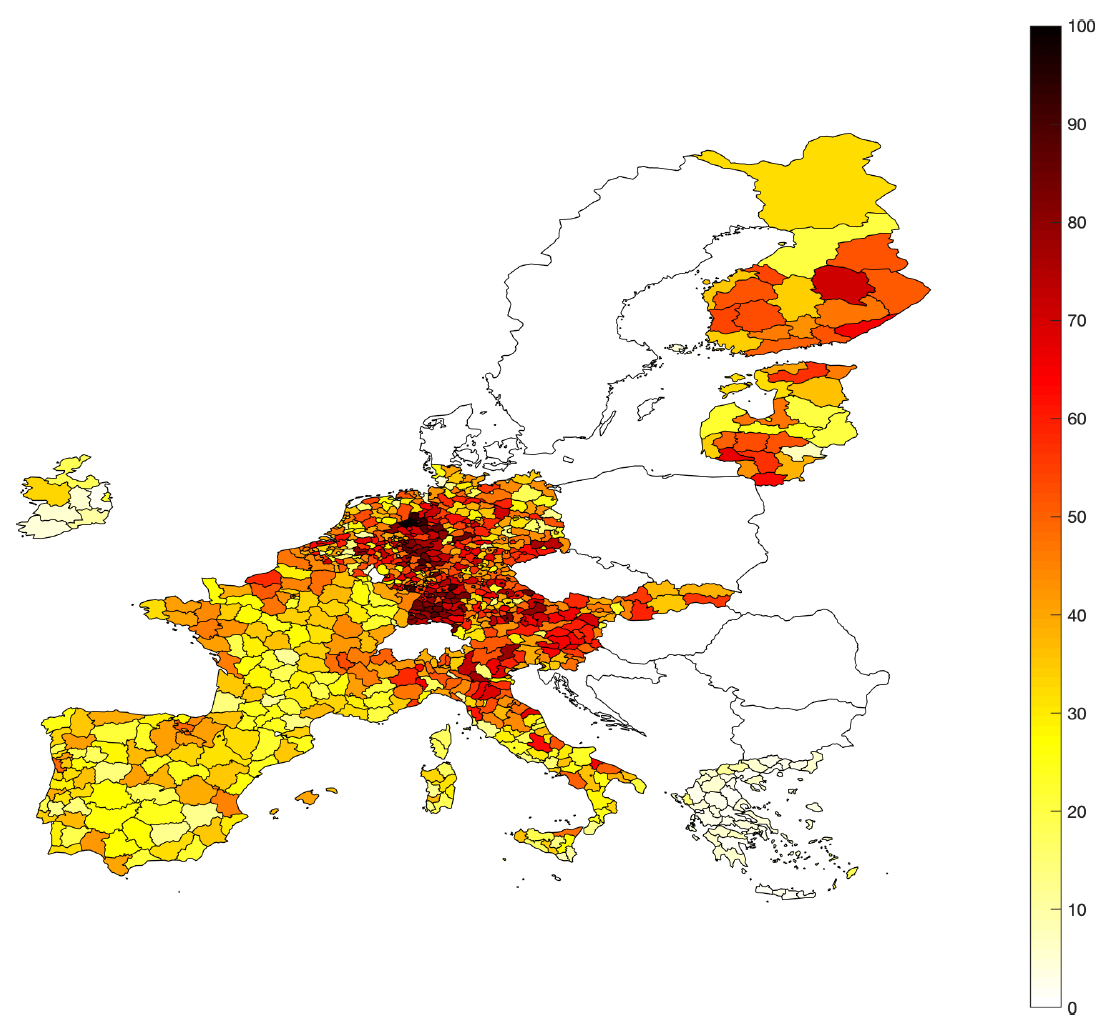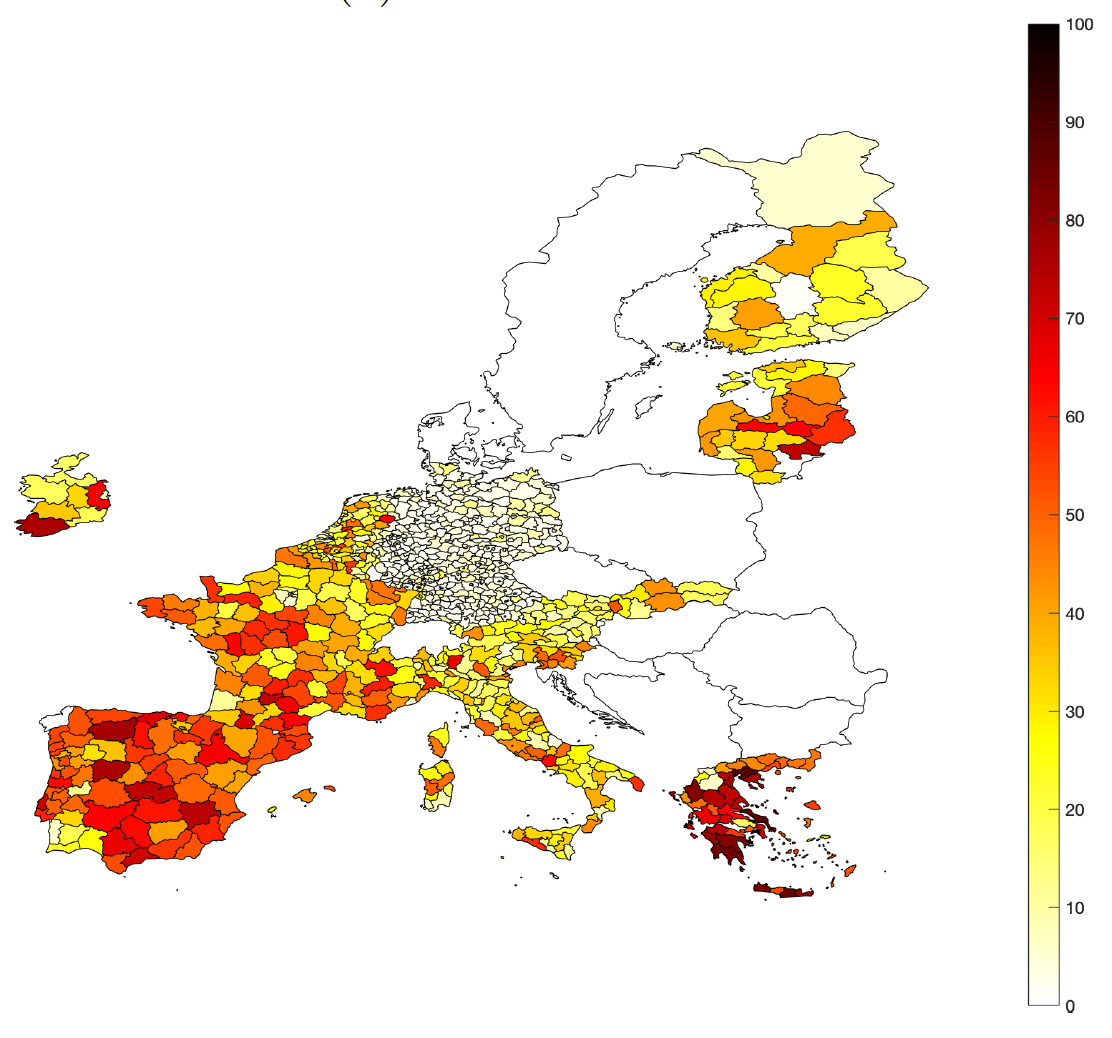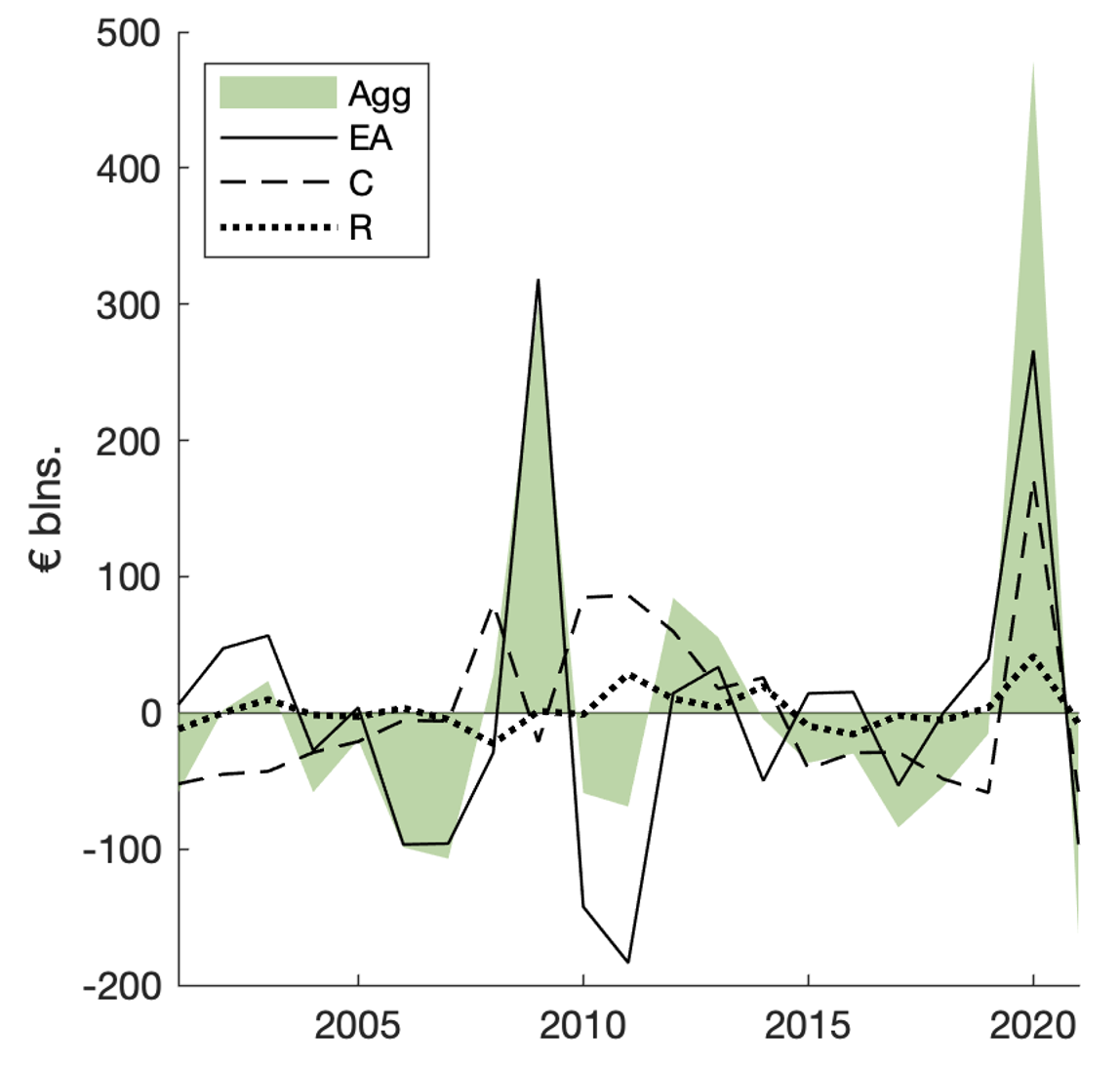The crises over the past 15 years, culminating with the recession triggered by the Covid-19 pandemic, have shown that the architecture of the European Economic and Monetary Union (EMU) is still incomplete in several dimensions. Apart from the absence of a fully-fledged banking union and a capital market union, the EMU lacks a fiscal union that facilitates cross-border risk sharing through central-level fiscal instruments (Van Rompuy et al. 2012).1
Hence, several proposals have been made for a central fiscal capacity (CFC) that allows EMU member state economies to be stabilised in response to adverse macroeconomic shocks (e.g. Juncker et al. 2015, Arnold et al. 2018). Existing proposals mainly aim at cushioning the effects of euro area-wide or country-specific shocks. The recently established EU Recovery and Resilience Facility (RRF), adopted in response to the Covid-19 pandemic, has some features of such a CFC.2
None of the existing CFC proposals targets region-specific shocks. Regional shocks are important business cycle drivers and can come from different sources – for example, from a natural disaster hitting a specific region or from the sectoral specialisation of a given region. Importantly, stabilisation of regional shocks may usefully complement monetary and national fiscal policies, which address shocks that are common across all regions in the euro area or across all regions of a country. In fact, these common policies will suit a wider range of individual regions when the latter feature business cycles that are better aligned.
In a recent paper (Beetsma et al. 2022), we propose a CFC for the euro area, in which transfers to and from regions are simultaneously driven by euro area-wide and country-specific shocks, but also by region-specific shocks. The scheme is highly flexible and can be easily modified in response to new crises. The main advantage of our proposal is that it encompasses the shocks coming from the three levels (euro area, national, and regional) into one single scheme, thus allowing more or less weight to be given to one level versus another according to political and economic considerations.
Our proposed transfer scheme works as follows. First, we collect data on regional output growth for 928 NUTS3 euro area regions from 1999 until 2021 (from the European Commission’s ARDECO dataset). Second, we decompose regional output growth (in deviation from the region’s historical average) into three different components, or ‘factors’, which may be viewed as distinct business cycles: a euro area-wide component, a national component, and region-specific one.3 Indeed, intuitively, one can think of a region being influenced by common shocks hitting the whole euro area (e.g. the global financial crisis in 2009 or the Covid-19 pandemic in 2020), shocks affecting only one country or a sub-set of euro area countries, and shocks hitting a specific region or a few regions but not all other regions in the same country. Third, fiscal transfers from the CFC are engineered to (partially) compensate for each of these shocks. Importantly, the scheme is symmetric. Therefore, in periods of growth above historical average, a specific region would contribute to the scheme.
Figure 1 shows that the euro area factor explains most of output variation in the Western part of Germany, Northern Italy, some regions in Eastern France, the Netherlands, and Belgium. Together, these regions broadly correspond to what is traditionally considered as the ‘euro area core’. However, for some other countries, the country factor is by far the most important driver of regional output. Greece, for example, was highly exposed to the sovereign debt crisis, which had country-specific features.
The regional factor is important in some parts of the euro area periphery, namely, most of Ireland and some regions of Greece, the South of Italy, and Portugal. Interestingly, most of Eastern Germany and South Italy also fall into this group. This may not be surprising. These areas are economically less developed and less active in competing on the EU internal market.
Figure 1 Contribution of factors at different levels in explaining regional output
a) Euro area factor
b) Country factor
c) Idiosyncratic factor
Note: The figure shows the contribution of (a) the euro area factor, (b) the country-specific factor and (c) the idiosyncratic-regional factor to explain the variance of regional output, for each of the 928 NUTS regions included in the sample, over the period 1999-2021. A darker colour indicates a larger contribution of the specific factor to the regional output variation.
Figure 2 depicts, for each euro area country (excluding Cyprus, Luxemburg, and Malta), the transfers generated by the three levels of the scheme as well as the total transfer (the shaded area), aggregated over all the regions of the country. The solid line reflects the transfers aimed at offsetting euro area shocks, the dashed line the transfers generated by the country-specific shocks, and the dotted line the transfers targeting region-specific shocks. Positive values indicate that the country is a net receiver, negative values indicate a net contribution.
These results show that every country would have received a net transfer to cushion the euro area-wide shocks of the 2009 great financial crisis and the 2020 Covid-19 pandemic. Transfers prompted by country-specific factors predominantly flow to countries that were mostly hit by the euro area sovereign debt crisis: Greece, Ireland, and, to a lesser extent, Spain. Not surprisingly, the net transfers associated with the region-specific shocks are on average close to zero for each country; in every year, some regions are receivers and some others contributors, depending on their relative position in the regional business cycles. The ‘netting out’ effect of the transfers associated with the region-specific shocks is an attractive feature of our CFC, as it reduces the need for the CFC to borrow on the capital market and minimises net transfer flows between countries.
Figure 2 Net transfers to individual countries from the CFC
Note: The figure shows the country transfers generated by the scheme in response to aggregate eurozone shock (solid line), country-specific shocks (dashed line) and region-specific shocks (dotted line). The shaded area represents the total transfers that a country pays or receives, which are the sum of the three components. Data are in percent of GDP.
Figure 3 depicts the aggregate transfers (of each level of the scheme and the total) aggregated over all euro area regions, in euros, in each of the sample years. We observe that there is a substantial positive net flow of transfers in 2009 and 2020. These are the years when, respectively, the global financial crisis and the Covid-19 pandemic struck hardest. The positive net flow in 2009 is ‘financed’ by negative transfers in the relatively good years preceding the crisis and the two years after 2009, when economies were recovering. In those years, on average, regions contributed to the scheme. It is interesting to observe that the net positive flows in 2009 plus 2020 are of roughly the same order of magnitude as the RRF, i.e. around €750 billion, when summed. Importantly, cumulative transfers over the years converge to roughly zero at the end of the sample, i.e., in 2021, which indicates that the transfers scheme is broadly balanced, ex-post, thus limiting potential moral hazard.
Figure 3 Aggregate transfers for the euro area
Note: The figure shows the monetary transfers aggregated over the whole euro area.
All in all, we show that our CFC can produce substantial stabilisation with a relatively limited need to borrow by the system as a whole in any given year. We also show that, on average over the last two decades, substantial stabilisation could have been achieved in response to the euro area and the region-specific shocks. At the same time, country-specific shocks were on average smaller and therefore needed less stabilisation.
Discussion
Our proposed central fiscal capacity ties in with the current discussion in the EU. Various international institutions view a CFC as an important complement to the current EU fiscal architecture. The value-added of a CFC would be particularly large in the presence of extreme shocks when at the same time national or local governments find it difficult to borrow on the capital market.
An important question concerns the practical implementation of our proposal. Three main issues are at stake. One is the need for timely data on the economy. In practice, the scheme would need to work with real-time data, i.e. data available at the time of the policy decision, which are however often revised at a later stage (for example, for 2022, the scheme would be based on preliminary data published for 2022). However, it may also be reasonably expected that with technological progress and more high-frequency data (such as on financial transactions) real-time macroeconomic data become more accurate.
Another issue is how aggregate transfers, which combined dampen the shocks from the three layers in the CFC, can flow from and to regions in need. The answer hinges on the degree of fiscal decentralisation within countries, among other factors. There are two possibilities, depending on whether a country is strongly centralised or decentralised. One possibility is that net transfers are channelled via the central government of the country, which forwards them to the regions in need. This option would be more effective in case of centralised countries with relatively small regional fiscal responsibilities. Another possibility is that transfers flow directly from the CFC to the regions in need, bypassing the central government. This option would work better with strongly decentralised countries.
Finally, a question pertains to how regions can spend the transfers they receive. One possibility would be to top up unemployment benefits. Another would be to make additional public investments. This would require a pipeline of projects ready to be implemented.
Eventually, the political feasibility of a CFC will crucially depend on how well the current RRF is implemented. The latter is quite widely viewed as an embryo of a potential CFC and, hence, its success will affect the perception of potential moral hazard under a CFC, as well as confidence in EU facilities in general.
Authors’ note: We thank Oscar Arce, Ettore Dorrucci, Ferdinand Dreher, Federic Holm-Hadulla, Christophe Kamps, Nadine Leiner-Killinger, and Johannes Lindner for their useful comments. This column reflects the views of the authors and not necessarily those of any of the institutions they are affiliated with.
References
Arnold, N, B Bergljot, H Ture, H Wang and J Yao (2018), “A central fiscal stabilization capacity for the euro area”, IMF Staff Discussion Notes No. 03, Washington, D.C.
Beetsma, R, J Cimadomo and J van Spronsen (2021), “One Scheme Fits All: a Central Fiscal Capacity for the EMU Targeting Eurozone, National and Regional Shocks”, CEPR Discussion Paper 16829.
Buti, M and N Carnot (2018), “The Case for a Central Fiscal Capacity in EMU”, VoxEU.org, 7 December.
Buti, M and M Messori (2021), “Euro area policy mix: from horizontal to vertical coordination”, CEPR Policy Insight No. 113.
European Fiscal Board (2018), Assessment of the fiscal stance appropriate for the euro area in 2019, Brussels.
Feld, L (2018), “Whither a fiscal capacity in EMU”, VoxEU.org, 31 July.
Heijdra, M, T Aarden, J Hanson and T van Dijk (2018), “A more stable EMU does not require a central fiscal capacity”, VoxEU.org, 30 November.
Kose, M, E Prasad and M Terrones (2003), “How does globalization affect the synchronization of business cycles?”, American Economic Review 93(2): 57–62.
Juncker, J, D Tusk, J Dijsselbloem, M Draghi and M Schultz (2015), Completing Europe’s economic and monetary union, European Commission, Brussels.
Van Rompuy, H, J Barroso, J-C Juncker and M Draghi (2012), “Towards a genuine economic and monetary union”, Policy Note, European Council, Brussels.
Endnotes
1 See, for example, Buti and Carnot (2018) and Buti and Messori (2021). However, not everyone would agree on the need for a CFC (e.g. Feld 2018, Heijdra et al. 2018).
2 The RRF entered into force on 19 February 2021. It made available €723.8 billion in total to EU countries (€385.8 billion in loans and €338 billion in grants).
3 Technically, this decomposition is implemented by means of a ‘multi-level’ Bayesian factor model (e.g. Kose et al. 2003).










